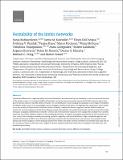Heritability of the limbic networks
Abstract
Individual differences in cognitive ability and social behaviour are influenced by the variability in the structure and function of the limbic system. A strong heritability of the limbic cortex has been previously reported, but little is known about how genetic factors influence specific limbic networks. We used diffusion tensor imaging tractography to investigate heritability of different limbic tracts in 52 monozygotic and 34 dizygotic healthy adult twins. We explored the connections that contribute to the activity of three distinct functional limbic networks, namely the dorsal cingulum ('medial default-mode network'), the ventral cingulum and the fornix ('hippocampal-diencephalic-retrosplenial network') and the uncinate fasciculus ('temporo-amygdala-orbitofrontal network'). Genetic and environmental variances were mapped for multiple tract-specific measures that reflect different aspects of the underlying anatomy. We report the highest heritability for the uncinate fasciculus, a tract that underpins emotion processing, semantic cognition, and social behaviour. High to moderate genetic and shared environmental effects were found for pathways important for social behaviour and memory, for example, fornix, dorsal and ventral cingulum. These findings indicate that within the limbic system inheritance of specific traits may rely on the anatomy of distinct networks and is higher for fronto-temporal pathways dedicated to complex social behaviour and emotional processing.
Citation
Budisavljevic , S , Kawadler , J M , Dell'Acqua , F , Rijsdijk , F V , Kane , F , Picchioni , M , McGuire , P , Toulopoulou , T , Georgiades , A , Kalidindi , S , Kravariti , E , Murray , R M , Murphy , D M , Craig , M C & Catani , M 2016 , ' Heritability of the limbic networks ' , Social Cognitive and Affective Neuroscience , vol. 11 , no. 5 , pp. 746-57 . https://doi.org/10.1093/scan/nsv156
Publication
Social Cognitive and Affective Neuroscience
Status
Peer reviewed
ISSN
1749-5016Type
Journal article
Description
This work was supported by the MRC UK (grant number G0400061) as the AIMS (Autism Imaging Multicentre Study) with support from the National Institute for Health Research (NIHR) Biomedical Research Centre at South London and Maudsley NHS Foundation Trust, King’s College London, and the Sackler Institute for Translational Neurodevelopment. Additional funding was provided by the European Autism Interventions—A Multicentre Study for Developing New Medications (EU-AIMS), which received support from the Innovative Medicines Initiative Joint Undertaking (grant agreement number 115300), including financial contributions from the EU Seventh Framework Programme (FP7/2007-2013), the European Federation of Pharmaceutical Industries and Associations companies in kind, Autism Speaks, NARSAD, The Stanley Foundation, Schizophrenia Research Trust and Psychiatry Research Trust. M.C. is the recipient of a Wellcome Trust Investigator Award (103759/Z/14/Z).Collections
Items in the St Andrews Research Repository are protected by copyright, with all rights reserved, unless otherwise indicated.

